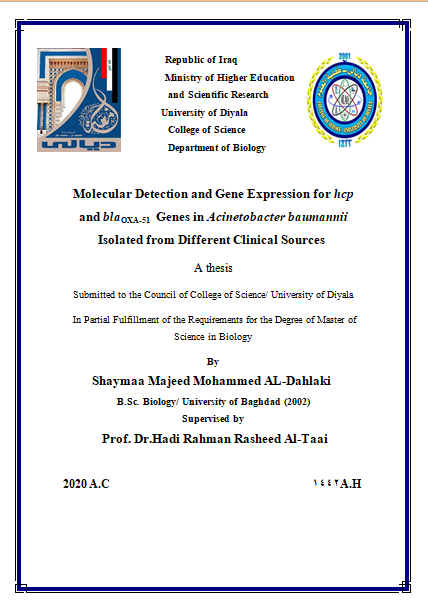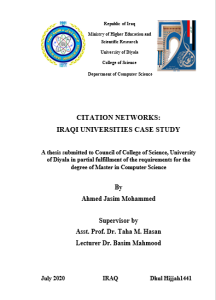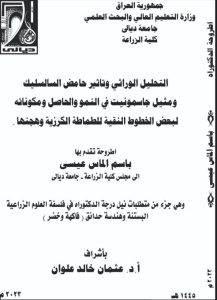Summary
Acinetobacter baumannii one of the important multidrug-resistant (MDR) opportunistic nosocomial pathogens, in part due to its high capacity of acquiring resistance to diverse antibiotic groups. Twenty isolates (9.7%) of Acinetobacter baumannii were obtained from (207) clinical specimens including infections of wounds ,burns ,sputum and blood from both male and female, different ages, diverse local regions .One hundred and sixty-two specimens had been given positive growth while Forty-five specimens showed no growth. The isolates were collected during the study period from the initial September /2019 till at the end of January /2020. The samples were collected from visitors and hospitalized patients in governmental hospitals in Baquba / Diyala. The visitor's percentage 57.97%, but the hospitalized patients' percentage was 42.03%.
A. baumannii initial diagnosis was made by culture media (MacConky and blood agare), and depending on the features of the cultures, biochemical tests, and VITEK 2 Compact system GN,final confirmation of diagnosis and identification was done using blaOXA51 gene.The positive numbere of A.baumannii isolates were high percentage in burns 8(40%), then blood 7(35%), wound 4 (20%) and the later was sputum only 1(5%) isolate.
The antimicrobial susceptibility of A.baumannii isolates was determined by disk diffusion method. The results showed that all the isolates 20(100%) were resistance Pipercillin-tazobactam,Cefotaxime, Ticarcillin–clavulanic acid,Amikacin, Gentamicin, Levofloxacin, (95%)for Imipenem,Meropenem( , (90%)for Ceftrixone, Ceftazidime, ( 65%)for Tetracycline, (55%)for Ampicillin-sulbactam, and(20%)for Doxycycline
The twenty isolates of A.baumannii were differentiation for two patterns according to antibiotic resistance, 15(75%) MDR isolates were resisted to (5-9)antibiotics, while 5 (25%) of XDR isolates were resisted(12 -13) antibiotics.
The results for all 20 of MIC showed that the values for Imipenem ranged from( 8-≥1024) μg/ml more than the MIC values for(≤4-128) μg/ml for Meropenem.
The β-Lactmases had been detected for three classes were (ESBLs, AmpC, MBLs). The results of ESBLs showed that all the isolates were with high resistance (100%) for Cefotaxime and Ceftazidim. The isolates also showed high resistance to piperacillin (PRL) and Augmentin (AMC) (100%).However, there was no synergy between the antibiotic discs.
Cefoxitin resistant test was ok to detect AmpC production. The results showed that 6 (30%) isolates were positive, three from burns, one was from blood, one isolate was from sputum, and one isolate was from the wound.
The results of MBLs phenotypically were positive for A. baumannii isolates that formed MBLs enzyme was 18 (90 %) isolates, but 2(10 %) isolates were negative. The results of molecular detection by conventional PCR were showed that 14 (70%) isolates of A. baumannii were possessed blaVIM gene, but 6 (30%)isolates did not possess it, and all the 20 isolates did not possess blaNDM-1, blaIMP genes.
Detection of virulence factor was done to determine the aggressiveness of A. baumannii. Biofilm formation was detected by two methods, qualitative assay by the tube method, this is the first step of the ability of bacteria to form a biofilm, The results showed that all isolates showed purple ring after staining by crystal violate, and quantitative assay by Micro-titer plate method. The results were 7 (35%) of the isolates were strongly biofilm-forming while 12 (60%) for moderately biofilm-forming and 1(5%) weak biofilm formation.
The colorimetric method was used to detect quorum sensing (Q.S). The isolates were producer to Q.S signals in various percentages, 7(35%) of A. baumannii isolate were a high producer of Acyl-Homoserine-Lactones molecules, while 11(55%) isolates that exhibited moderate, and 2(10%) isolates were no formation activity of AHL.
conventional PCR technique was used to detect hcp gene as a molecular marker of a functional T6SS. The results showed that the prevalence of this gene 95%, it presented in 19 isolates, but one isolate did not have it.
Real-Time qRT PCR Technique (Syber green) was used to study gene expression after treatment by (128)μg/ml (sub MIC) concentration of Imipenem for two genes, blaOXA51 gene for Carbapenems resistance and hcp(T6SS). The blaOXA51 gene gave a high expression of different degrees in 3 3isolates from wounds, burns, and blood. The level of folding with the average of 1.45 was more than the expression of control, but The hcp gene gave a low expression compared with the control in different degrees in these 3 isolates with average folding 0.88.
Sequencing was performed for one(Ab.13) isolate of A. baumannii. Concerning 16S rRNA amplicons, the results indicated that the amplified 16S rRNA fragment exhibited five nucleic acid variations, g.422C>T, g.431A>C, g.433C>T, g.806T>C, and g.918-919G ins compared with the referring ribosomal sequences. Concerning the hcp amplicon, the results showed that the amplified hcp locus exhibited one silent mutation (g.279978C>T) compared with the referring region sequences. The generated hcp-based phylogenetic tree indicated that the investigated sequences were accurately positioned in the A. baumannii sequences. The utilization of a comprehensive tree for the phylogenetic positioning of the currently investigated sequences using the hcp gene had given confirmed identity with respect to the phylogenetic relationships of the investigated sample as well as to the accurate phylogenetic positioning within the sequences of A. baumannii. This notion, in turn, indicates the feasibility of utilizing the currently targeted hcp gene fragment in the precise determination of the investigated identity of A. baumannii.
One strain of A. baumannii was isolated from a human source in Baquba city /Diyala and the sequences have a symbol code (SHRRWY.80) with the accession (MT551041), and variation (MT551041.1) for 16s rRNA, and with the accession (LC553000)and variation ( LC553000.1) for hcp gene.




